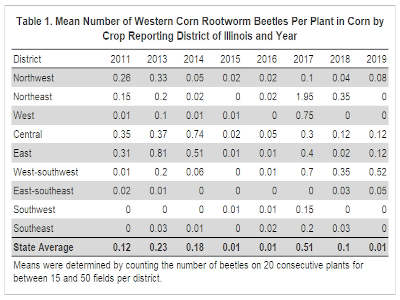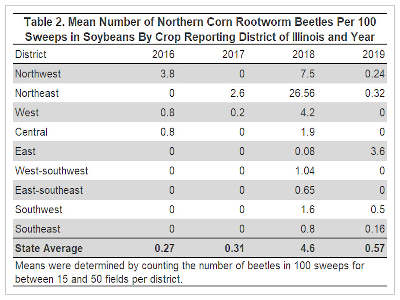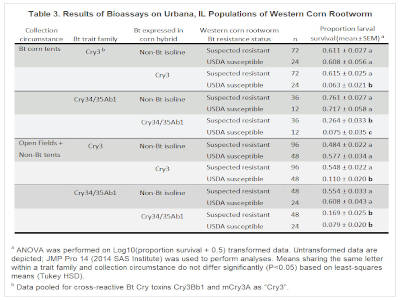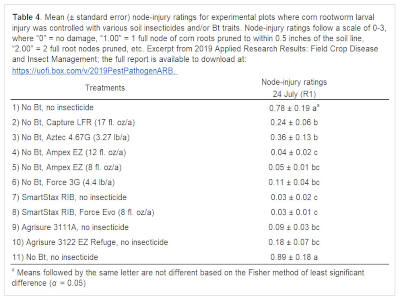

The development of resistance to Bt traits in the western corn rootworm is an ongoing problem, with critical implications for management. During 2019, offspring from seven Urbana, IL western corn rootworm populations (collected in east-central Illinois in 2018) were evaluated for resistance to the Cry3Bb1, mCry3A and Cry34/35Ab1 Bt toxins expressed in commercial corn hybrids. Single-plant Bt resistance bioassays (Gassmann et al. 2011) compared the survival of larvae from potentially-Bt resistant local populations to USDA Bt-susceptible laboratory populations. Because of cross-resistance between the structurally similar Cry3Bb1 and mCry3A toxins, results for those toxins were combined and analyzed as the “Cry3” trait. These bioassays indicated that all Urbana western corn rootworm populations were resistant to the Cry3 toxins, regardless of their collection circumstance. These larvae survived as well on Cry3 Bt corn hybrids as they did on non-Bt isoline hybrids (Table 3). As expected, USDA susceptible population larvae had significantly reduced survival on both Bt hybrids compared to non-Bt isoline hybrids. Bioassay results indicated no evidence of resistance to the Cry34/35Ab1 toxin among the offspring of Urbana, IL western corn rootworm beetles collected from open fields and from within tents over non-Bt hybrids. However, among the offspring of parental western corn rootworm that developed on Bt corn hybrids and inter-mated with other Bt survivors within tented plots of Bt corn, there was significantly reduced susceptibility, but not resistance to the Cry34/35Ab1 toxin. The larvae from this population survived on Cry34/35Ab1 at a higher rate than those from the USDA susceptible colony, but at a reduced rate compared to their survival on non-Bt corn (Table 3). These results suggest that Cry34/35Ab1 resistance genes are detectable in local western corn rootworm populations. Fortunately, East-central Illinois western corn rootworm populations still retain some susceptibility to the Cry34/35Ab1 toxin. Given resistance to Cry3 toxins, it is sobering to realize that the efficacy of most pyramided Bt hybrids may be largely dependent on continued rootworm susceptibility to the Cry34/35Ab1 toxin.

Despite ongoing resistance development to these individual Bt proteins, pyramided trait packages have generally performed well in Illinois over the last several years. Where unexpected damage has occurred in these pyramided hybrids, it has primarily been in northern Illinois and associated with continuous corn. In east-central Illinois, these pyramided trait packages and a variety of soil insecticides continue to provide effective control, especially under the low to moderate pressure situations that have been typical in recent years (Table 4). However, the use of rootworm control in Illinois generally exceeds what is needed based on rootworm pressure due to difficulties in monitoring this insect and the potential for yield losses if a needed control is not applied. This is especially true given recent low population densities, which provide an opportunity for producers to cut back on control costs when monitoring indicates a low risk of rootworm damage in their local area.

Ideally, rootworm control decisions should be based on the results of in-field monitoring of adults conducted the previous year when adult emergence is mostly complete (typically late July-mid August). When monitoring corn rootworms with a standard yellow sticky card trap, use an economic threshold of 1.5 beetles per trap per day (10 beetles per trap per week) in first-year corn, and a threshold of 2 beetles per trap per day (14 beetles per trap per week) in continuous corn (Dunbar and Gassmann 2013). Extended diapause allows some northern corn rootworm to overcome crop rotation as a management tactic – a proportion of their eggs deposited in a cornfield remain in the soil for 2, 3, or even 4 years before hatching, allowing them to hatch into rotated corn. Fields with high populations of northern corn rootworm adults are at risk of rootworm damage for 2-3 additional seasons, complicating management decisions when this species is present in rotated corn. (Note, however, that extended diapause also reduces the intensity of the damage by reducing the proportion of eggs that hatch in a given year). Where control decisions are made without access to monitoring data, consider including some untreated strips within the field to determine whether control was in fact justified. Where a control is necessary, use either a pyramided Bt hybrid targeting corn rootworm or a labeled rate of a soil insecticide.
Whatever control you choose to implement, you should monitor its effectiveness by examining some roots for pruning sometime after pollination but before black layer. When using a pyramided Bt hybrid for rootworm control, greater than ½ of a root node pruned to within 1½-inches is considered greater-than-expected damage, and should be reported. When resistance is suspected, the best mitigation strategy is to rotate the field(s) to soybean. Though crop rotation in Illinois does not necessarily protect first-year corn as it once did, planting soybean after corn does reduce the local population – any eggs that hatch in a soybean field will die. Populations with resistance to both crop rotation and a Bt trait have been observed in Illinois. However, it should come as no surprise that new instances of resistance to a Bt protein have always been observed first in areas with continuous corn production. Corn rootworm remains our most serious insect pest of corn in Illinois, but low western corn rootworm populations mean that the current risk in rotated corn is lower than it has been since rotation resistance was first observed in the early 1990s.
Source : illinois.edu